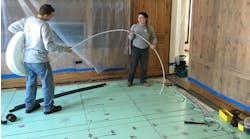We ended last month's column having looked at the individual wire core circuit type of electric radiant heating system. I failed to mention that although this product was intended for use as a radiant floor heating system, there really is no limit to where you can use the product within reason. To be safe, always follow the manufacturer's installation guidelines. Radiant walls, ceilings and granite or concrete countertops are excellent candidates for this product. For the more adventuresome, they even make a system for use below the floor to avoid ripping up an existing floor to apply the product. Obviously, when applied below the floor, this system has many of the same issues that its hydronic cousin has in overcoming resistance values placed between it and the space that you are trying to condition.
Conductive polymers
Continuing with our review of alternatives to hydronic radiant heating, we now will look at the use of heating with electrically conductive polymers.
As we discussed with the single-wire methodology, there are numerous manufacturers of the film-type heat emitters. They also come in a variety of voltages such as low (24V), medium (120V) and high (240V), and they are available in either AC or DC configurations. The DC configurations have a lot of appeal to people building homes off the normal electric grid using photovoltaic solar cells and, in the future, hydrogen fuel cells. By their nature, hydrogen fuel cells generate a DC electrical current that typically is converted to an AC signal to be compatible with common appliances. By avoiding inverter losses, the efficiency of the fuel cell is higher than usual.
These film types of heating units come in varying widths of 1-ft. or 3-ft. and in varying lengths limited by wattage demands. They are made of carbon and plastic or electrically conductive plastic only. In most cases, a properly trained person can install them. In the case of the low-voltage system, they can be completely wired up to the high-voltage side of the transformer by a non-licensed electrician. (Check your local code requirements.) Even the high- and medium-voltage manufacturers claim that the heat generating mat can be installed by a non-licensed person, with the final connections being made by an appropriately licensed electrician. For the most part, these systems are automatically “self regulating” and limited to the typical 85°F temperature for radiant floors. Some of the manufacturers recommend against the use of a room temperature limiting thermostat, claiming that it will defeat the purpose of the product's self-limiting nature. In the case of the plastic film, as the plastic film heats up, the resistance changes such that it quits heating. As it cools down, it contracts and again changes its resistance, causing it to heat up. This is helpful when the floor will be exposed to varying temperatures, such as in front of a door or in front of a south-facing room. If the door is opened and the floor cools off, that area will heat up. If the sun is shining through the window and onto the floor, the floor temperature will rise from the solar gain, but the electric mat will stop generating heat. This in and of itself is an attractive feature.
The film type of heater also is not as susceptible to nail hits that cause a break in the circuitry, which could completely eliminate the operation of the heating mat. Because it is essentially a parallel group of circuits, it can withstand nail and screw holes in the film without causing heating element failure. It is important that the cold leads not become damaged during installation, but the cold leads are fairly obvious.
Advantages: Relatively easy layout and installation instructions make it ideal for the “Do-It-Yourselfer.” As with all electric applications, it allows for small applications of radiant surfaces (floors, walls, countertops and ceilings). The cost also is substantially lower than the price of doing a small area with a full-blown hydronic heat source, even if a new circuit has to be installed from the panel to the point-of-use. These thin film materials are significantly more conducive to being used on alternative surfaces such as walls, ceilings and countertops. The limitations are only as limited as your mind's eye. Fogless mirrors anyone?
As with any radiant heat source, you must insulate behind the heat source to gain control over the directional flow of energy, regardless of the application. Always check with the manufacturer prior to design and installation to ensure that you are in compliance with the product's applicability.
Disadvantages: As I mentioned earlier in last month's column, these prefabricated units come to cover specific square-foot areas. Those pre-packaged areas do not always meet the needs of the consumer, resulting in either having to field-modify or add another individual loop to accommodate odd spaces. The manufacturers are limited to the square footage of coverage by the fusing and power availability requirements. In other words, a 12-in. wide element that is 20-ft. long would have to be limited to a 7-ft. length if the 3-ft. wide element were to be used. This requires a lot more attention to detail in the layout scheme of things. All of the manufacturers I reviewed offered design assistance in those areas to ensure proper and complete application.
Most installations will require the use and availability of special tools for making field connections from the power source or cold leads to the actual heat emitting film. Most manufacturers will loan, rent or sell these tools to the end user. Once you have decided which system best suits your needs, you will want to purchase these devices to ensure availability.
Tune in next month as we continue to discover alternatives to hydronic radiant heating systems. I also will introduce a product that I feel will revolutionize the installation of any human comfort system — radiant windows. Imagine if you will, virtually no heat loss from the windows …
Until then, keep your powder dry and your lips wet.
Mark Eatherton is a Denver-based hydronics contractor. He can be reached via e-mail at [email protected] or by phone at 303/778-7772.

